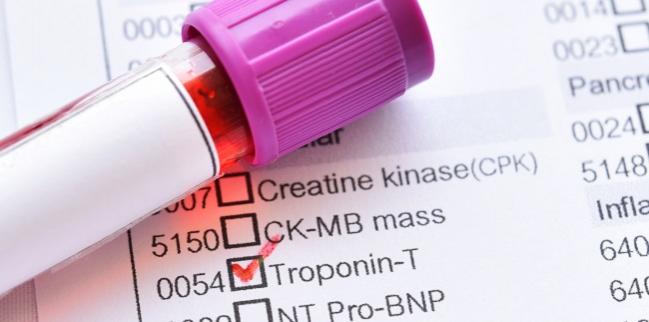Tool May Ease Use of High-Sensitivity Troponin for Acute MI Diagnosis
One expert commended the effort but said there remains a need to verify the concepts in a US setting.

After gathering data from more than a dozen patient cohorts, researchers have developed a risk-assessment tool incorporating high-sensitivity cardiac troponin measurements to aid in the diagnosis of patients who present to the emergency department with suspected acute MI.
The instrument, which can found in interactive form at www.compass-mi.com, takes into account troponin levels at presentation, absolute changes over time, and the timing of serial sampling to estimate the likelihood of MI at the index visit and the risk of subsequent MI or death at 30 days.
Johannes Neumann, MD (University Heart Center Hamburg, Germany), and colleagues describe the tool and its performance in a study published in the June 27, 2019, issue of the New England Journal of Medicine.
Putting patients in the low-risk category “may allow for the discharge of patients after other life-threatening causes of chest pain have been ruled out,” they say. On the other hand, “patients assigned to the high-risk category have a high prevalence of myocardial infarction and a high risk of death. Therefore, the majority of these patients are candidates for early invasive strategies.”
For those who don’t fall into either category, “it would be important . . . to undergo detailed clinical evaluation, monitoring, further diagnostic testing, and invasive strategies as appropriate,” the investigators write.
Commenting for TCTMD, Richard Nowak, MD (Henry Ford Health System, Detroit, MI), said this is “a great paper that attempts to put together a number of trials looking both at troponin I and troponin T and how they might be used clinically for the evaluation of acute MI, or acute cardiac injury for that matter.”
But he highlighted one major limitation: the dearth of evidence from multicenter studies conducted in the United States. Most of the studies included in this analysis were conducted in Europe, where patient populations and the use of high-sensitivity troponin tests may differ, he noted. To illustrate that point, Nowak cited the 15.3% rule-in MI rate in this study, which is higher than what he estimated is 10% to 12% in the US as a whole and 7.7% at his center.
“And that’s because we much more broadly apply troponin screening because we’re all really worried about missing some sort of myocardial infarct, myocardial injury, or something of that nature,” he said. What’s needed is validation in a large number of US patients, Nowak added, pointing out that there will soon be publications coming from the now-completed HIGH-US study, which enrolled about 2,500 all-comer patients at 29 American centers to evaluate the performance of high-sensitivity troponin I assays.
There probably won’t be huge differences between the US and non-US data, but the risk-assessment tool might need to be tweaked for American patients, Nowak said.
COMPASS-MI
As part of the COMPASS-MI project, Neumann and colleagues pulled individual patient-level data from 15 international cohorts in which tests for high-sensitivity troponin I (Architect platform; Abbott) or high-sensitivity troponin T (Elecsys platform; Roche) were used in patients with suspected MI. The studies included a total of 22,651 patients from 13 countries in Europe, North America, and Australasia, while 9,604 and 13,047 were included in the derivation and validation cohorts, respectively.
The investigators evaluated a variety of troponin cutoffs, placing patients in the low-risk group if all measurements were below the threshold and in the high-risk group if all measurements were at or above the threshold.
In general, lower troponin concentrations at presentation and smaller absolute changes across multiple measurements were associated with a lower likelihood of MI at the index presentation and a low short-term risk of MI or death. In an example given by the researchers, a troponin I concentration below the cutoff of 6 ng/L at presentation and an absolute change of less than 4 ng/L after 45 to 120 minutes would provide a negative predictive value of 99.5% for ruling out MI. The estimated 30-day risk of MI or death would be low at 0.2%.
Conversely, higher troponin concentrations at presentation and greater changes on serial sampling were associated with an increased likelihood of acute MI and a greater risk of 30-day MI or death.
“The development of high-sensitivity troponin assays allows for the identification of small-scale myocardial injuries, thus improving the detection of even small myocardial infarctions. However, owing to the higher analytic sensitivity of these assays, clinical management decisions have become more challenging. Consequently, algorithms have been developed to triage patients with suspected myocardial infarction efficiently,” Neumann et al explain.
But, they say, “these algorithms have inflexible rules for the timing of troponin resampling and cutoff levels for the diagnosis of myocardial infarction. In contrast, the COMPASS-MI approach provides risk probabilities for myocardial infarction using a wide range of cutoff combinations of high-sensitivity troponin I or T concentrations, as well as thresholds that are based on either early or late serial sampling.”
The investigators also were interested in exploring longer-term outcomes among patients who had MI ruled out at the index visit. When compared with people participating in the population-based BiomarCaRE consortium, the rule-out patients had an elevated estimated risk of MI or death at both 1 year (3.9% vs 1.0%) and 2 years (6.3% vs 2.6%). There were strong relationships between high-sensitivity troponin values and adverse outcomes, and the paper includes charts to aid in long-term risk prediction.
Todd Neale is the Associate News Editor for TCTMD and a Senior Medical Journalist. He got his start in journalism at …
Read Full BioSources
Neumann JT, Twerenbold R, Ojeda F, et al. Application of high-sensitivity troponin in suspected myocardial infarction. N Engl J Med. 2019;380:2529-2540.
Disclosures
- The study was funded by the German Center for Cardiovascular Research.
- Neumann reports receiving grants from the German Heart Foundation/German Heart Research Foundation and the Else Kröner-Fresenius-Stiftung, as well as personal fees from Abbott Diagnostics and Siemens.


Comments